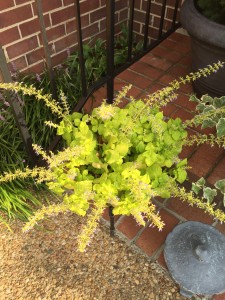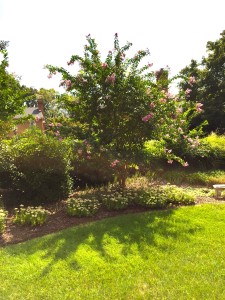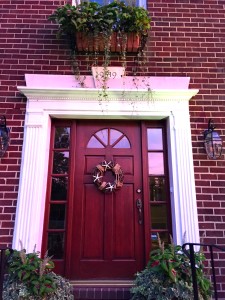
This pretty lemon/lime coleus has done well in the summer heat — watering it at least once a day has been the key! It attracts butterflies and hummingbirds, too!
Here in the mid-Atlantic, this has been a really rough summer, and the climate change has been very pronounced. Officially, it is the second hottest summer on record. With well over 50 days of temps in the mid-90’s and higher, the plants and trees are struggling — so much so that I am rethinking the location of many different plants in my garden. The micro-climate in my yard is hotter than the officially recorded temps by usually around five degrees. I think that is mostly due to the fact that we don’t have many shade trees on the property.
It’s a good time to take inventory of how the plants are faring. I think it’s interesting to compare how the same variety of plants do on various sides of the house, getting sun at different times of the day.
I am concerned about a row of euonymous that I planted along the front walk. Each spring, they start off looking amazing and full but lose their leaves by the end of summer, leaving them looking like bare stalks — not pretty. Those will be removed, and in their place I will add more liriope, and just fill the walkway garden with it, since it has done exceptionally well in that exposure.
The other hits in the front garden are the Hyacinth bean vine that I started from seed from last year’s winner, and also this gorgeous lemon/lime coleus with purple flower stalks. Both of these have been attracting butterflies and hummingbirds!

The purple flowering hyacinth vine started from last year’s seeds has also come into its prime in this heat.
On the other side of the house in the east garden, I have a huge amount of beautiful white iris that are struggling in the intense amount of afternoon sun, as well as lamb’s ears that are always looking bedraggled. They will both be removed as well. The garden on that side is now getting established, and the crepe myrtle trees have grown to a point that they are blocking an unappealing view, so I couldn’t be happier about that! I might not even install anything else in that garden, and leave them some extra space. Deep watering has kept them in good health, so just adding some extra mulch is all that is needed.

The underplanted iris and lamb’s ears will be removed to give the crepe myrtles more space. They are exceptional trees for hot climate and have grown quite a lot this season.
In the back yard, I have some renovating to do. After 20 plus years, and even a move from our old house to this one, the planters we built from pressure treated wood are on borrowed time. I am rethinking how we might rework a privacy screen for under the deck, and then add to the flowering bounty underneath. The knockout roses and beautiful peonies that I currently have in pots, as well as some of the white iris I am removing from the east garden will be planted there. I’ll increase the garden’s size to accommodate them as needed. They’re my “green children” after all!
I have a couple of beautiful photos to share of the Labor Day weekend’s sunset here, and a last photo of this summer’s front door — next time you see it, it will be decked out for autumn, and hopefully a lot cooler! Until then — Happy gardening!





